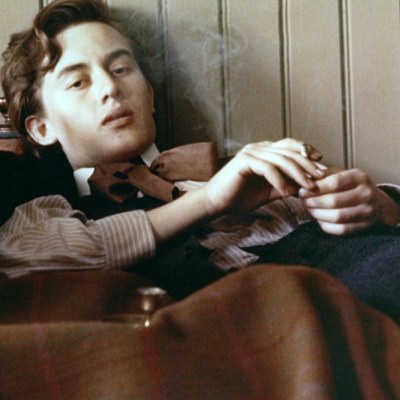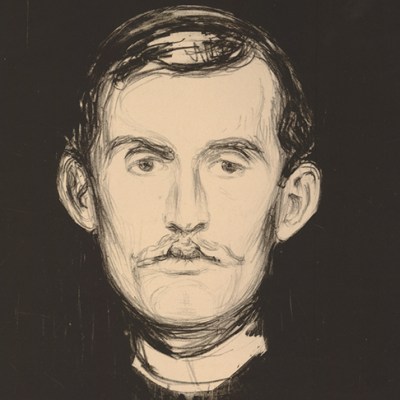From the April 2024 issue of Apollo. Preview and subscribe here.
I first saw Fjord Landscape (1906) when I was studying philosophy at the University of Oslo, in so far as I ever managed to study that subject in any meaningful sense. It was inspired by Henrik Ibsen’s play Ghosts (1881). At the time, I was meant to be writing some scintillating piece of verbiage on the Norwegian philosopher Arne Næss, but I was reading Ghosts instead. It’s a wild, eerie play about unhappy families, divorce, venereal disease, euthanasia and prostitution. Ibsen was a major influence on Munch and their lives and works were entwined in many interesting ways. They were born several decades apart – Ibsen in 1828 and Munch in 1863. They first met in 1895, when Munch showed Ibsen round an exhibition of his paintings in Oslo. One of the works on display, Woman in Three Stages (Sphinx), is said to have inspired Ibsen’s final play, When We Dead Awaken (1899). Themes from Ibsen’s work recur throughout Munch’s paintings; he was also buoyed by Ibsen’s refusal to yield to baying critics with their accusations of immorality, insanity, degeneracy and other 19th-century equivalents of the Twitterstorm. Both left Norway for long periods: Ibsen went to Italy and Germany, Munch to Germany and France. Both returned home in later life. They once had a row in Oslo’s Grand Cafe about an unpaid bill, which ended with Munch crying, ‘Well Ibsen. We will not be seeing each other again.’ But that was just a storm in a teacup, or perhaps a highball glass.
In 1906, shortly after Ibsen’s death, Munch was commissioned to paint various scenes for a Berlin theatre production of Ghosts, including Fjord Landscape. The Norwegian title of Ibsen’s play, Gjengangere, means ‘a thing that walks again’, and the play is full of recurring ‘ghost-like’ phenomena: memories that won’t fade, secrets that won’t be suppressed, dead ideas, ossified conventions. Ibsen’s poetic stage directions explain that the action takes place ‘by a large fjord in western Norway’ where the landscape is always ‘gloomy […] veiled by steady rain’. Munch’s painting is a wonderful evocation of this setting: vast, implacable mountains rising from gelid waters, the colours muted by bad weather. Everything is pale and indeed ghost-like. Nothing moves; there is no one around. Yet the painting conveys a sense of existential trepidation, as if at any moment the superficial tranquillity might be shattered by a cataclysmic event.
Fjord Landscape (1906), Edvard Munch. Munch Museum, Oslo. Photo © Munchmuseet/Sidsel de Jong

Munch wrote that ‘explaining a picture is impossible’. Not quite impossible (I hope), though at times baroque, is explaining why you like a picture. Munch created ‘soul paintings’ – non-realist landscapes conveying torrential feelings of terror, hope, love, anguish, joy and more terror. He lived in several stunning places on the Oslofjord, including the coastal town of Asgardstrand, the island of Jeloya and the town of Kragero, and many of his paintings evoke fjord landscapes. Behind the figure in The Scream (1893), there’s even a hint of fjord, the sun boiling above vermillion waves. In 1910, Munch was living in Kragero as he painted one of his most monumental works, The Sun. It hangs in the University Aula in Oslo, like a pantheistic altar piece. I spent lots of time there, drifting off in lectures and other illustrious events, staring at this massive sun, its mesmerising rays emanating to the edges of the canvas. Even this apparently triumphal work contains a lingering ghost of Ghosts, as it were. Ibsen’s play ends with Oswald crying out for ‘the sun, the sun’, which in that play is aligned with revelations, secrets being dragged into the light. Such revelations are painful and terrifying, Ibsen and Munch both seem to say. Yet they are necessary for any kind of freedom, however tenuous, and for any life that is truly lived and not just feigned.
When I look at Fjord Landscape I imagine Munch in Berlin, in 1906, paying homage to Ibsen. He’d once waited for Ibsen on the steps of a gallery in Oslo, nervous and hopeful. Now Munch was commemorating Ibsen’s work and mourning him too. Fjord Landscape depicts a double or even triple haunting, or maybe more. It’s a sepulchral, anti-realist landscape, painted by an artist haunted by Ibsen, by Ibsen’s Ghosts and by all the ghosts of the dead; an artist who is haunting Ibsen’s play in turn and re-enchanting it in his own way. The painting embodies that strange alchemical process by which artistic and literary works resonate across generations, the past haunting the present and the present re-enchanting the past – an infinite number of hauntings in the end.
From the April 2024 issue of Apollo. Preview and subscribe here.


